UDL Guest Post: The Little School That Could
March 17, 2016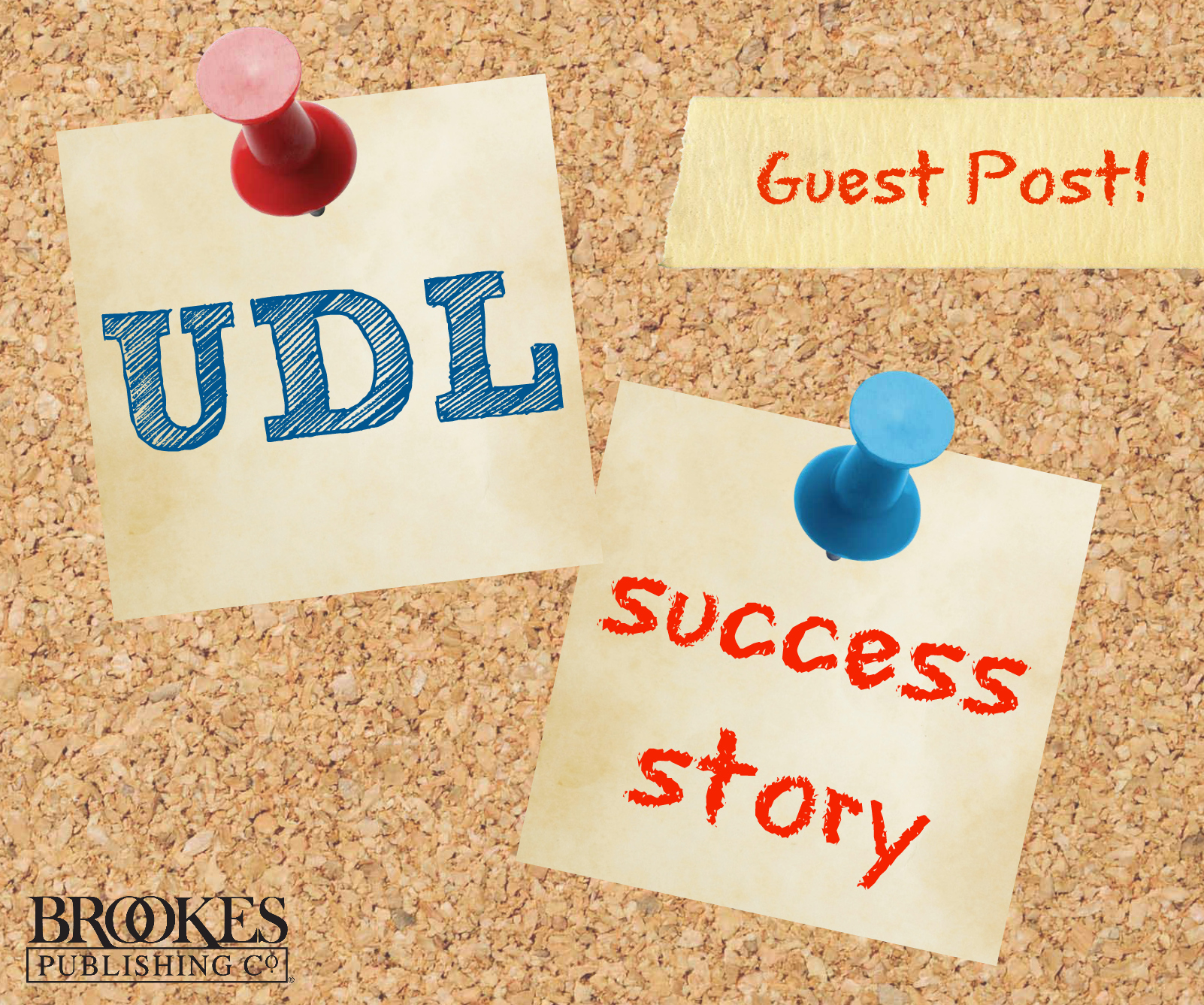
Greetings, Inclusion Lab readers (and happy St. Patrick’s Day to the Irish and part-Irish among us)! Today I’m excited to bring you another of Stephanie Craig’s fantastic UDL success stories (read the first one here). Stephanie is a UDL facilitator with so much wisdom and so many great examples of universal design for learning in action. Here she shares photos and examples from her experiences working with teachers at Indiana’s Mount Healthy Elementary School.
Over to you, Stephanie!
The Little School That Could
(Guest Post by Stephanie Craig, M.Ed., UDL Facilitator)
“You’re off to great places! Today is your day! Your mountain is waiting, so…get on your way!”–Dr. Seuss
In my position as UDL Facilitator, each day is an adventure that can turn on a dime. It’s all in the way you choose to look at what life throws your way. While situations can look dire up close, if we take the time to travel to a higher elevation and view things from above, we generally find that we have come a long way and things are not as bad as we thought.
In my district, every school is fortunate enough to have a half-time UDL Facilitator on site to support teachers with the implementation of Universal Design for Learning. One of my schools is a small rural school smack-dab in the middle of nowhere in Indiana. It’s the kind of place where you instantly feel at ease with the friendly staff. Nevertheless, there is something about this school that’s quite different (apart from its 1970s open-concept architecture). This small school has attracted visitors from faraway places like Japan, Belgium, and Sweden—as well as from other states in the continental U.S.—over the past few years.
What’s so different about this school? Let’s take a look at its UDL journey.
Our humble beginnings with UDL
Mount Healthy Elementary School has enjoyed many years of tranquil peace with decent state testing scores and little to no staff turnover. A small, almost undetectable change occurred about four years ago, though–think small wave building into a tsunami. Universal Design for Learning had been mentioned at staff meetings off and on, but teachers were assured that they already “did” UDL up to this point. Eventually a full twenty minutes was set aside for me to present information about UDL as I settled into my new position.
Fast-forward a couple of years and I am leading an entire meeting every month for UDL professional development. Two teachers have collaborated with me so that we all can learn the UDL Principles and Guidelines at a deeper level. Most of the staff now attends the optional professional development sessions, and I meet regularly with many teachers to give them support in their journey. A small legion of naysayers have desperately questioned all that we know is right and holy with neuroscience and declared UDL a passing phase, but I just fasten my life vest and meet each wave of pessimism with as much courage as I can muster.
“Arriving at one point is the starting point to another.””“John Dewey
Today, I often tell educators that UDL is much like a journey with many destinations. We have come a long way and many of the naysayers have been silenced by the excellent examples of UDL in action at Mount Healthy. Our school often has visitors from other states and countries who wish to see classrooms with higher levels of implementation and talk to the teachers who use the UDL framework as the standard for all their instructional decisions. We have teachers at all levels of implementation–some have emerged as UDL “rock stars,” while others are at the beginning of their UDL journey.
The UDL Rock Stars
I cannot express the respect and awe I have for the teachers who, despite the hoops they must jump through, persevere in creating safe, inviting, and accessible learning environments for all their students. Here are some examples of these UDL rock stars at Mount Healthy.
Kindergarten
Kristen Hollenbaugh shines as a UDL rock star. After moving from fourth grade to kindergarten two years ago, she shared some trepidation with me as to what UDL implementation would now look like. Once she remembered that UDL implementation at any grade level really begins with the learners and their needs, she has been a force to reckon with. The last time we had visitors, Kristen stepped out to answer questions about UDL with the group. I covered her class for twenty minutes and during that time, the only thing I had to do was set the timer for the next station rotation. Watching six-year-olds go to their next station, make a choice of what they would do, and begin working with no redirection from an adult clearly modeled how a learning environment can be designed to support independent learners.
As in many other classrooms, Kristen labels station areas and items around the classroom to support her non-readers. The labeling includes a picture and text in its bouma shape:
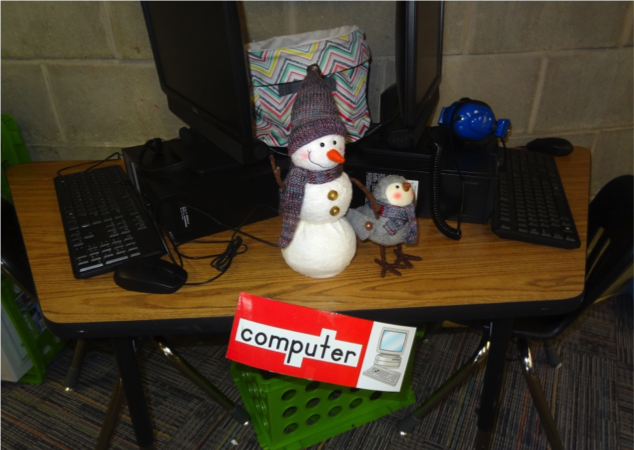
Many teachers have requested flexible seating for students. Shown here is a wedge seat for student with sensory processing issues as well as allowing for movement:
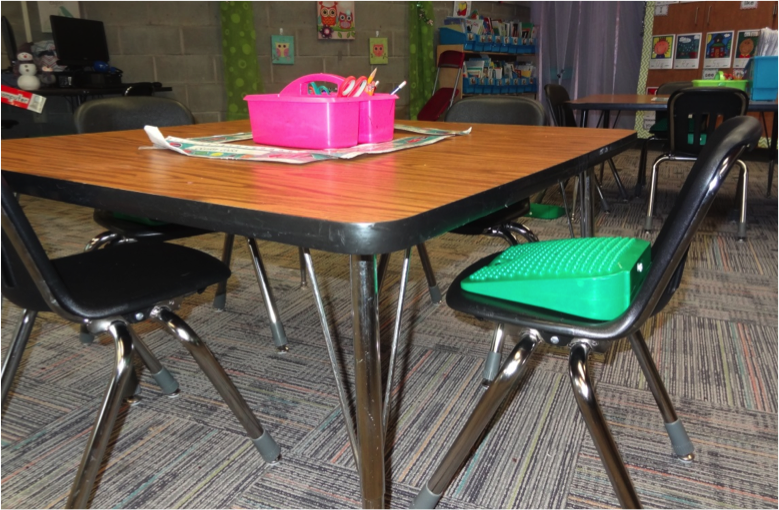
Kristen searches for resources to have in the classroom that will provide as many forms of representation for student comprehension as possible. Pictured here are numbers with different representations of that number:

Below are the large sight words in Kristen’s classroom. While there may not be space to put all resources at the desired eye-level for six-year-olds, having sight words in large type manipulates the words so that they can be visible to students at different locations in the classroom.

Pictured here is a visual writing rubric that gives students a concrete visual to compare their writing to in order to learn to self-assess their ability and score themselves. Exemplars and rubrics are necessary resources for students to learn expectations and give students immediate feedback on their product.

First Grade
Kelly Cunningham and Kim Smith are leaders in their unit. They have many years of experience teaching primary grades; add to that the fact that they are diligent in knowing their students and providing scaffolding and options that lift students to the curriculum, and you have a recipe for success. They design their learning environments with the learner variability in mind.
Kim Smith, like many teachers at Mount Healthy, builds in “brain breaks” throughout the day to support students’ self-regulation as well as reboot their brains with movement:

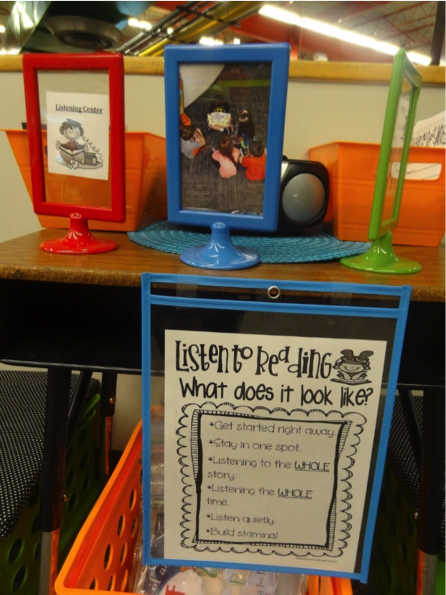
Both Kim Smith and Kelly Cunningham use a series of standard pieces in their stations:
- Color-coded materials for easy recognition
- Text directions with images
- Photo of students modeling what the expectations are in the station
Having these pieces supports first graders in being autonomous and gives students consistency.

Technology has changed the classroom environment, as it comes with a new set of skills for both teachers and students to learn. With it also comes the necessity of students learning digital citizenship. Pictured here are the rules for handling the Chromebooks in Kelly’s classroom. As is standard in her classroom, Kelly uses both text and pictures to support all students in understanding these rules.
Fifth Grade
Jennifer Justis is a master at creating a safe and collaborative environment. I have worked with Jennifer on the Expert Learner Project, a yearlong project to support students in becoming fluent with UDL language and developing expert learner qualities. Jennifer often greets me as I enter her room with “You will be so proud of me…” and proceeds to share a new idea she has implemented to support her students in becoming autonomous and engaged with learning.
Jennifer has posted the CAST UDL brain networks in her room. These posters served as a resource in one of our first lessons in our Expert Learner Project on neuroplasticity. Jennifer and I reference these often when we want to activate student awareness of their learning:

The fifth-grade art teacher at Mount Healthy, Janet Chasteen, uses multiple representations to inform students of her classroom expectations. Janet frequently refers to this resource as she teaches, making this a living resource:
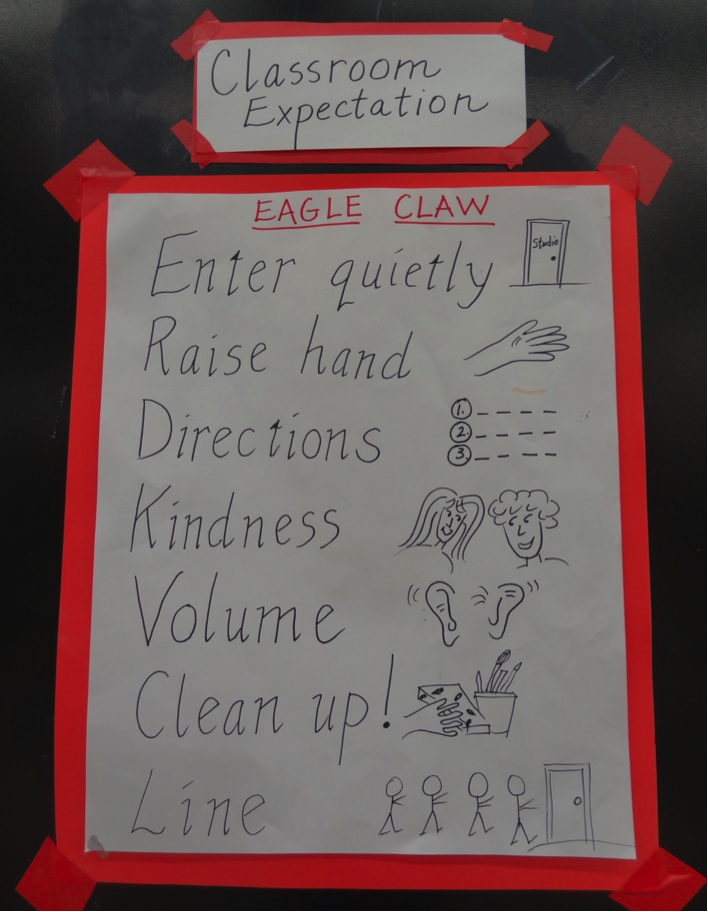
Commonalities among the accomplished fifth-grade UDL teachers include:
- Goals are posted daily and discussed
- Reflection is built in as an instructional piece
- Information is represented in multiple ways, including photos of how “it” looks
- Resources can be found easily by students
- Choices are designed with student preference in mind
- Technology is used as a tool and not an event
- Relationships are built through small group/individual instructional time
- Expectations are high and accompanied with scaffolding and challenge
- Teachers embrace the mindset that they can keep growing
UDL Up-and-Comers
While I have highlighted the “rock stars” at Mount Healthy, we also have up-and-coming stars. Here are a few examples of how they use UDL principles in their classrooms.
One teacher at Mount Healthy opted to get rid of desks altogether in her classroom. Pictured are first graders who sit at one of three tables or on the floor to work. Giving students the appropriate instruction on how to make the best choice for their learning is huge in this environment. The payoff with student engagement and autonomy outweighs the time spent preparing them.
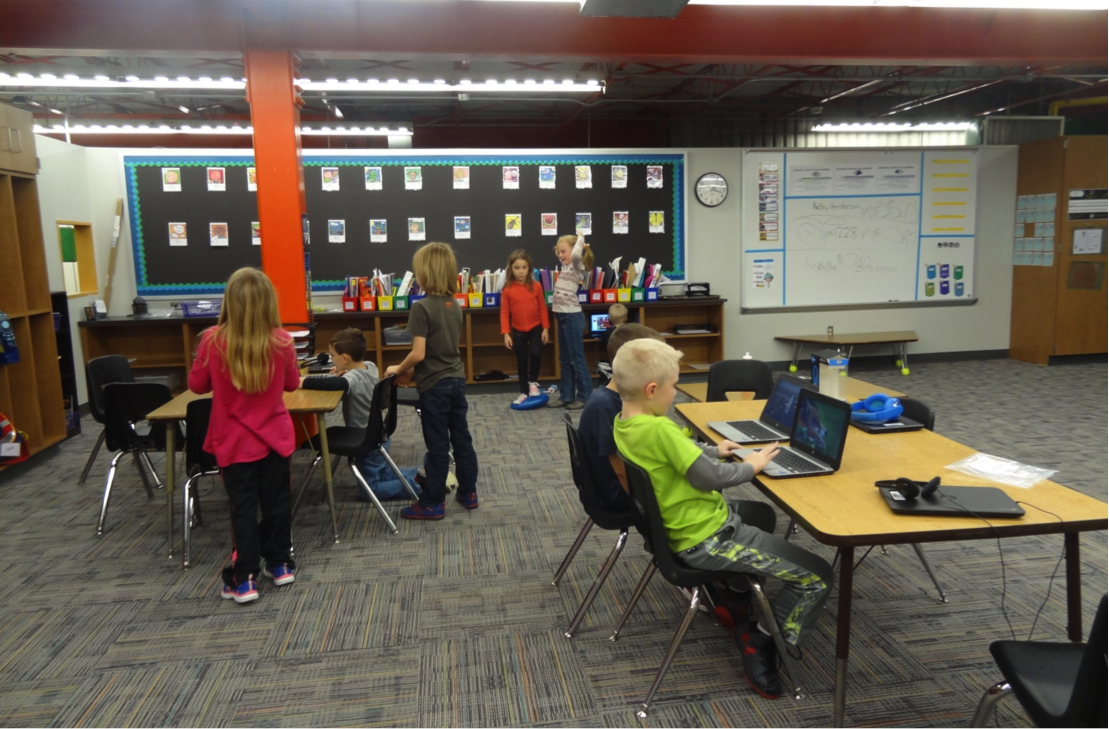
Chalkboard posters were created as a resource for teachers as they began instruction on the school-wide learning outcomes (SWLO) language. Becky Yates, a sixth-grade teacher, has all nine posters displayed and the current SWLO for the week highlighted with arrows. Some teachers use the electronic version of these posters weekly to support the instruction of the language and student understanding of the SWLOs. Walking into classrooms, you can hear students of all ages using the language as they go about learning.
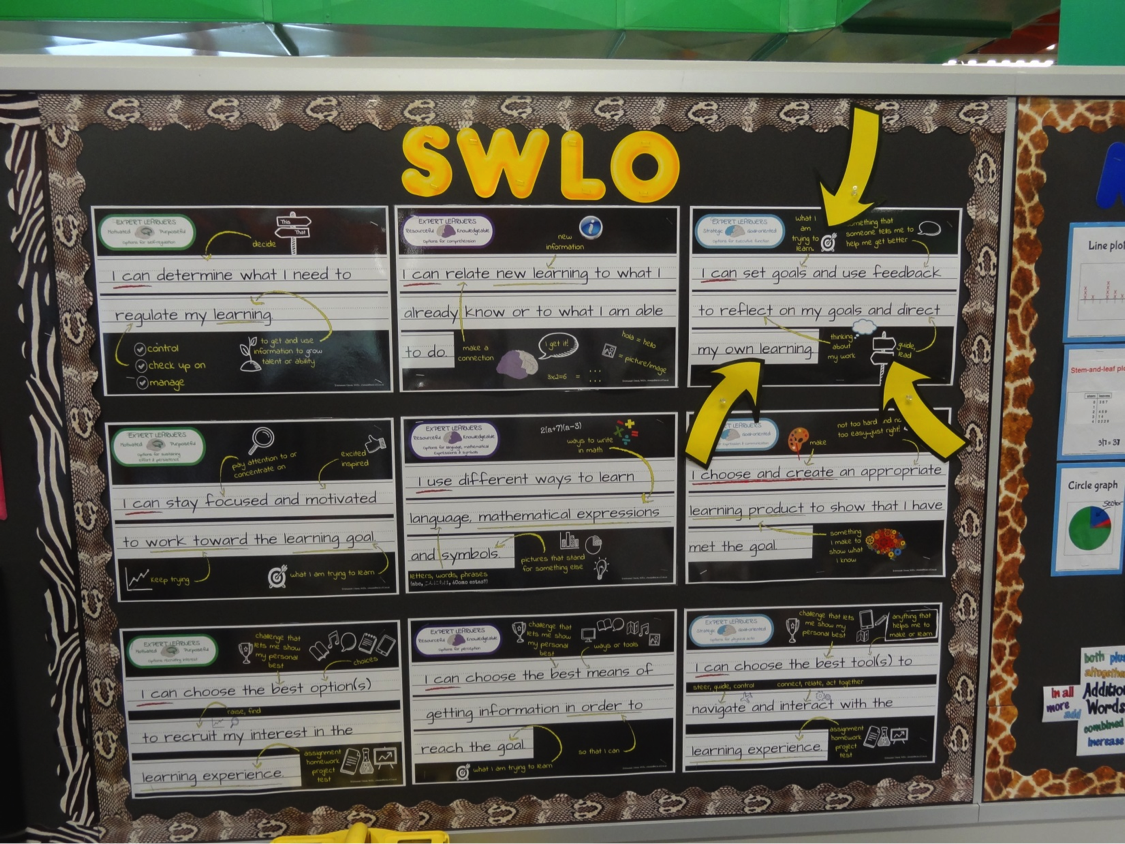
One technique that another sixth-grade teacher, Amy Nagel, uses during a novel study is a picture collage. She found as they read the novel Hatchet, many students did not have background knowledge of the flora and fauna featured in the novel. As they read, students would look up information online and find an image to help their classmates have a picture to refer to in their minds as they read. This supported their understanding of the language, which created a deeper comprehension of the story the author was telling.

The Small School that Could
The adventure I call my job allows me to enter environments that are morphing into places where a visitor would not know which students have an IEP. Appropriate support and challenge put all students on equal ground. Our staff has learned that:
- Teachers must be the “frontal lobe” for students as they develop their executive function skills.
- Students must have time daily to reflect on not just the “what” but also the “why” of learning.
- ALL staff working with students must understand the UDL framework (our paraprofessionals have UDL training quarterly).
- Choices must be intentionally planned and keep with high expectations–quality over quantity.
- Scaffolding withheld is likened to educational malpractice. It is not cheating!
- Specific feedback is as essential to learning as food and water is to living.
- A standardized test does not dictate access and support made available to a child; it is a snapshot of what that child can accomplish when access and support are made available.
- Ongoing learning for teachers through book studies, professional development, etc. creates fresh ideas and ignites the stamina to keep moving forward in supporting our students’ journey in learning.
I am honored to be a resource in such a wonderful school with educators who always put students first!
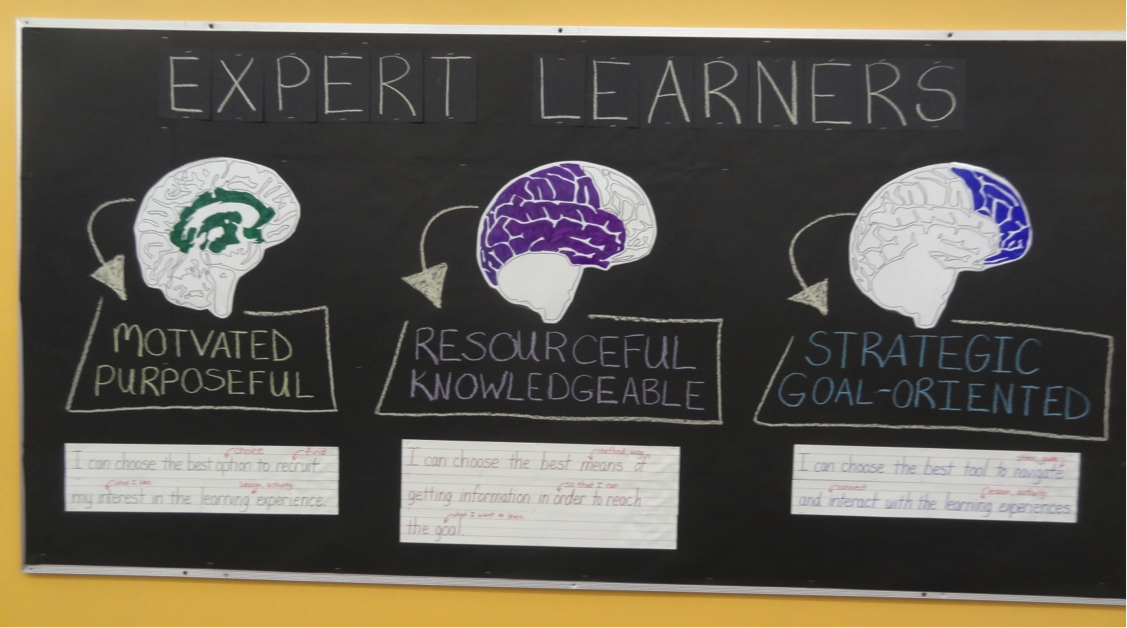

Stephanie Craig, M.Ed., UDL Facilitator
Stephanie has 13 years of teaching experience at the elementary level as both classroom and Title One teacher. Currently as UDL Facilitator, Stephanie participates in professional development of instructional design with teachers, and provides background information and resources for UDL to teachers for intentional accessibility of instructional practices. Stephanie collaborates with teachers and administrators with the goal of making UDL planning more intentional and purposeful. Ms. Craig has been a UDL presenter at various conferences and guest speaker at classes in the Elementary Education Program at Indiana University-Purdue University Columbus, and facilitator at the BCSC Summer UDL Institute for the last three years. You can follow Stephanie on Twitter @slcraig1910 or contact her here craigs@bcsc.k12.in.us.




Write a Comment
Your email address will not be published. Required fields are marked *
comments
Tomica Crosby says
Good morning, I recently came across your Hatchet collage on your page and loved the idea. Would you happen to have a clearer picture or a copy of the individual pictures that you used to complete it?
Thanking you in advance.
jlillis says
Hi Tomica,
I'm glad you liked the collage! This isn't something we created; the photo was submitted to us by our guest poster who wrote this article. Since the photo was taken at a school where she worked as a half-time UDL facilitator and was not created by her, I don't think she would have access to the individual photos, but I can ask.
Post a Comment